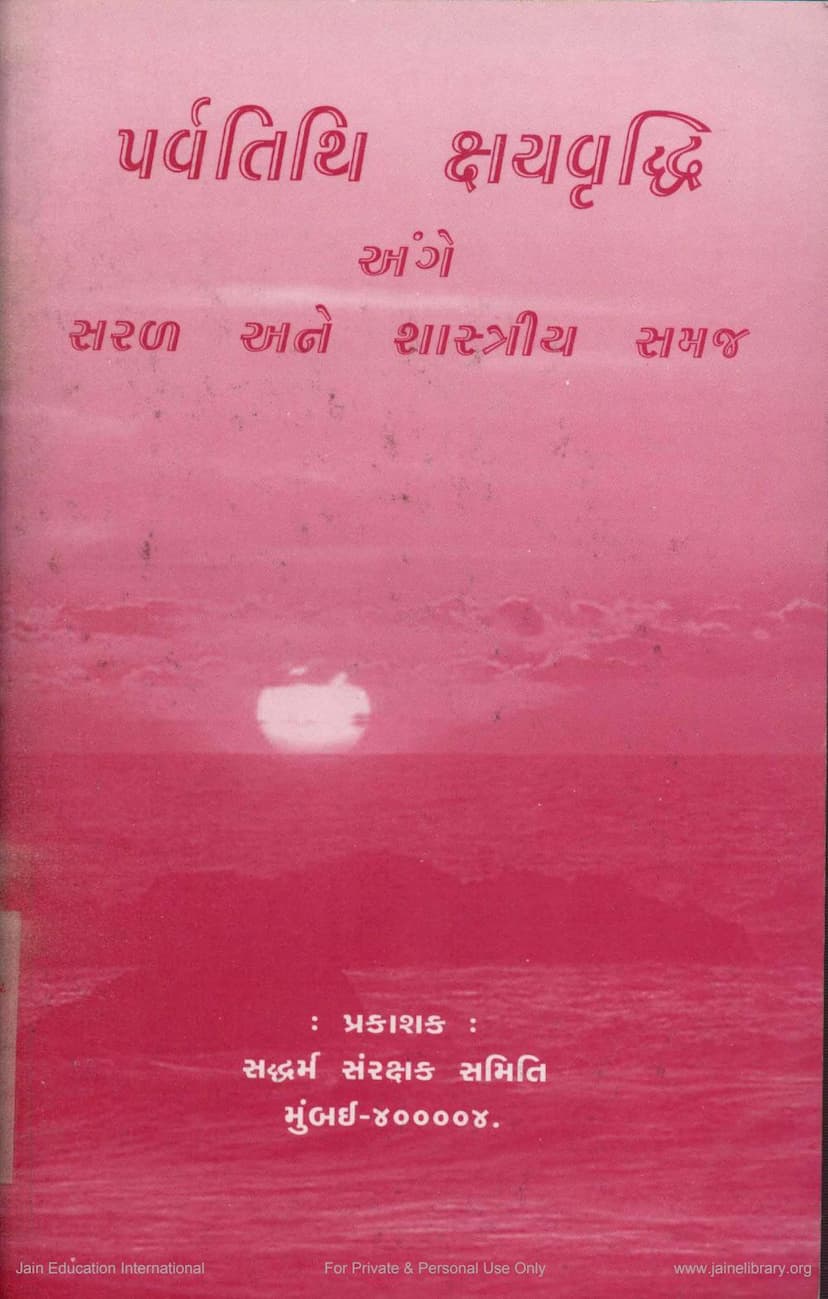Parvatithi Kshay Vruddhi Ange Saral Ane Shastriya Samaj
Added to library: September 2, 2025

Summary
This document, titled "Parvatithi Kshay Vruddhi Ange Saral ane Shastriya Samaj" (Simple and Scholarly Understanding of Festival Tithi's Increase and Decrease), published by the Saddharm Samrakshak Samiti Mumbai, is a comprehensive treatise on the complexities of determining and observing Jain religious dates (tithis), particularly in relation to festival observances like Paryushana and Samvatsari.
The core of the text revolves around a theological and jurisprudential debate within Jainism concerning how to correctly observe religious festivals when the lunar calendar (tithi) experiences "Kshay" (decrease) or "Vruddhi" (increase). The book presents the scholarly views of respected Acharyas, primarily focusing on the teachings of Acharya Shrimad Vijay Ramchandrasurishwarji Maharaj, and incorporating the insights of Acharya Sagar-anand Suriji Maharaj and other revered figures.
Here's a breakdown of the key themes and arguments presented in the document:
1. Importance of Tithis in Jainism:
- The text strongly emphasizes the significance of observing specific tithis for important Jain festivals like Samvatsari, Paryushana, Mahapanchami, etc.
- It highlights the daily practice of inquiring about the current tithi and auspicious events.
2. The Role of Panchangas (Almanacs) and the Loss of Jain Panchangas:
- The document acknowledges that the loss of traditional Jain Panchangas due to historical circumstances has led to the reliance on Laukik (secular/worldly) Panchangas for tithi determination.
- It cites scholarly opinions from texts like "Shri Paryushana Sthiti Vichar" and the words of Acharya Shrimad Siddhsen Divakar Surishwarji Maharaj, suggesting that Laukik Panchangas, when aligned with Jain principles, can be considered valid as they are derived from ancient Indian astronomical knowledge that also influenced Jain texts.
3. The Core Debate: Kshay (Decrease) and Vruddhi (Increase) of Tithis:
- Kshay: When a tithi is shortened and does not span a sunrise, it is considered to have decreased. The scholarly consensus cited is that in such cases, the observance should take place on the previous tithi.
- Vruddhi: When a tithi extends over two sunrises, it is considered to have increased. The scholarly consensus presented, citing the teachings of Umaswati Vachak and others, is that in such cases, the observance should take place on the following tithi, not the first day of the extended tithi.
- The book counters the notion that Kshay means the tithi "disappears" entirely or that Vruddhi means two distinct tithis are present. It clarifies that Kshay relates to the tithi not being present at sunrise, and Vruddhi relates to a tithi spanning two sunrises.
4. Historical Context and Disagreements:
- The document delves into the historical evolution of this debate, tracing disagreements back to different Gachhas (sects or lineages) that emerged centuries ago.
- It criticizes the "laxity in conduct and discourse" that allegedly led to deviations from original principles, particularly concerning tithi observance.
- A significant portion of the text is dedicated to refuting a particular publication called "Shasan Jayapataka," which is described as presenting a one-sided and potentially misleading perspective. The text recounts the efforts to counter this publication through scholarly debate and the creation of a counter-volume, "Aham Tithi Bhaskar."
5. Scholarly Support and Citations:
- A substantial part of the book is dedicated to presenting extensive citations from various authoritative Jain scriptures and commentaries, including:
- Shri Paryushana Sthiti Vichar
- Shraddhavidhi
- Shri Heer Prashnottarani
- Sadhumarayadapattaka
- Sen Prashna
- Kalpa Sutra Kiranavali
- Kalpa Dipika
- Kalpa Sutra Subodhika
- Kalpa Kaumudi
- Pakshik Parvasar Vichar
- Siddha Chakra Masik Prashnottar
- And various letters and handbills from prominent Acharyas.
- These citations are used to demonstrate the consistent scriptural basis for the principles of Kshay and Vruddhi in tithi observance.
6. The Case of Samvatsari in Bhadrapad:
- The document specifically addresses the controversy surrounding the observance of Samvatsari, the most important annual festival, when the tithi of Bhadrapad Sud 5 experiences Kshay or Vruddhi.
- It provides a detailed historical analysis of how different lineages have interpreted and observed these events over the centuries, highlighting the views of Acharyas like Sagar-anand Suriji and Vijay Ramchandra Suriji.
- The text argues that the prevailing understanding for centuries, supported by numerous scriptural references, is to follow the sunrise tithi (Udayatmika) for festivals, and in cases of Kshay, to perform the observance on the previous tithi, and in cases of Vruddhi, on the subsequent tithi.
7. Critiques of Alternative Interpretations:
- The book criticizes practices that deviate from these scriptural guidelines, particularly those that attempt to "create" two tithis where they don't exist or ignore the principle of observing the sunrise tithi.
- It expresses concern over the spread of "unscriptural pronouncements" and "poisoning the ears of ignorant people."
8. Emphasis on Truth and Adherence to Vitaraga Vachana (Words of the Victorious):
- The underlying message is a call for adherence to the true teachings of the Jinas, transcending personal opinions, traditions that deviate from scripture, and the influence of kashayas (passions).
- The authors advocate for a dispassionate and scholarly approach to understanding and practicing the Dharma.
9. Call for Unity and Resolution:
- The document aims to provide clarity and resolve the ongoing disputes, encouraging unity within the Sangha based on scriptural truth.
- It expresses a willingness for further discussion and dialogue to achieve a consensus.
In essence, "Parvatithi Kshay Vruddhi Ange Saral ane Shastriya Samaj" is a scholarly defense and elaboration of the Jain principles for determining and observing festival dates, rooted in scriptural authority and historical precedent, with a particular focus on resolving contemporary debates surrounding tithi anomalies. It strongly advocates for the scientific and time-tested principles of observing the sunrise tithi and applying the rules of Kshay and Vruddhi as understood by the classical Jain tradition.